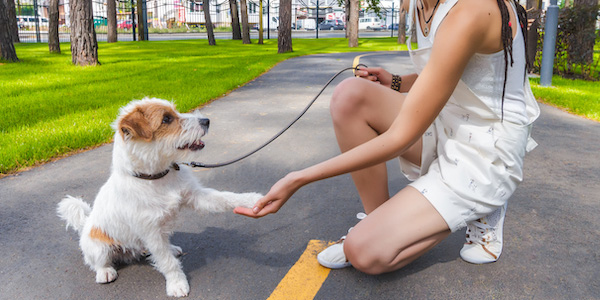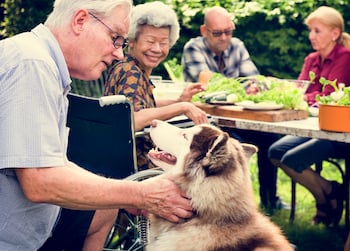 There are approximately 90 million dogs in the United States, and with the increase of dog-friendly workplaces, venues, and activities, you are more likely to see dogs out and about with their owners — at the office, running errands, during school pick up, at the gym, enjoying a beverage at the cafe, or relaxing at the park.
There are approximately 90 million dogs in the United States, and with the increase of dog-friendly workplaces, venues, and activities, you are more likely to see dogs out and about with their owners — at the office, running errands, during school pick up, at the gym, enjoying a beverage at the cafe, or relaxing at the park.
It’s tough to see an adorable pup and not want to go up and say hi — they’re just so cute and fluffy!
But you wouldn’t just run up to an adorable child on the street and fawn all over them without some basic introductions and asking for permission first, would you? Or when first meeting a new coworker, do you rush up and give them a big hug? Not so much … or at least you shouldn’t!
While the dog owner holds the most responsibility for not forcing their dog into uncomfortable situations, those of us who love dogs and just want to say hello can help set these dogs up for success.
Help Prevent Dog Bites
Just as some humans don't love to talk to everyone they see on the street, some dogs don't enjoy being pet by strangers. Others are fearful or stressed by certain types of people or clothing (men in hats, people wearing sunglasses, someone walking with a cane or umbrella), and being approached by someone can be extremely scary.
Some dogs, especially younger pups can get so excited and overstimulated by their environment that they have a hard time behaving, which can cause them to get nippy and practice unwanted behaviors like jumping or barking.
A dog bite is more likely if a dog is scared and feels like they can't run away, and unfortunately, when they are on a leash, they simply can't escape. While the dog owner holds the most responsibility for not forcing their dog into uncomfortable situations, those of us who love dogs and just want to say hello can help set these dogs up for success.
There is a right and a wrong way to approach and greet a dog. What we humans have to understand is that other people’s dogs are not there for our entertainment, and we are not entitled to their attention or affection.
However, if you practice polite greeting etiquette and behavior, and the dog is showing signs that they would enjoy this type of interaction, by all means, ask the owner if you can meet their dog!

Always ask the owner for permission to pet their dog.
If the dog is tethered outside of a shop or otherwise unattended, it's best to leave them be and just admire them from afar. Wait until their owner returns to ask if their dog enjoys meeting people and whether you can say hi.
Don't be offended if a dog owner says no when you ask to pet their dog. There are many reasons why someone might not want you to: their dog gets scared or doesn't like meeting people, their dog is in training, they don't have the time, etc. It's not personal.
Dog Owners: You are allowed to say no if someone asks to pet your dog! Rachel Fusaro does a wonderful job explaining how to do this in this video about how to introduce your puppy to new people:
Allow the dog to approach you.
Let the dog decide whether or not they'd like to meet you. Don't invade their space and force yourself on them. Stand calmly (or crouch down) with your hands relaxed at your sides.
While common advice is to extend your hand out for the dog to sniff, even this can cause some dogs to shy away or trigger a defensive bite if the movement startles them. A dog's sense of smell is amazing — they can smell you just fine from a few feet away without your hand in their space.
Avoid direct eye contact and staring.
Staring at a dog is really intimidating! Humans don't stare at each other when we talk — we'd find it quite creepy, really. Keep your eyes nice and "soft", with a relaxed face, and don't stare directly in the dog's face when greeting them.
Don't come in from overhead or directly behind a dog. Turn slightly sideways or crouch down.
Nicole Wilde calls it "overhead dread" — dogs do not enjoy things leaning over them or hands coming from above their head. But all too often we see people greeting a new dog by reaching out with a wide-spread hand and patting the dog directly on top of their head.
It's also common for many people to reach out and pet a dog from directly behind them.Think about how startling that must be for a dog! I'd sure jump out of my skin if someone just reached out and stroked me on the back without being warned ahead of time.
Instead, reach to pet the dog from the side or under their head and pet them on the side or back. Some dogs enjoy some scratches on the neck or chest as well. It all depends on the dog's individual preference.
It's a great idea to ask their owner if their dog has a favorite scratch spot. The goal here is to make sure the dog can see what you're doing so it can anticipate the physical touch and not be startled.
Don't encourage bad behavior.
If the dog starts to jump on you in excitement, help out the dog owner by not encouraging it or brushing it off with the "it's okay, I'm a dog person!" line. Dog owners invest lots of time and money to try and train unwanted behaviors like not jumping on people, and even just one person can cause this training to regress and confuse the dog.
If you're greeting a dog that jumps up on you, simply turn away or back up and ask the dog for a sit or other easy behavior. This way you're helping the dog learn that jumping means the thing they want (you!) goes away, but not jumping makes the thing they want come closer.

Learn how to read dog body language.
Know whether a dog wants to interact with you in the first place based on what their body language says. There are loads of wonderful dog body language resources available — check out our Resources to Decode Dog Body Language page to see some that we've rounded up for you.
A happy dog wanting to be touched will make it pretty obvious they are enjoying it by seeking out more interaction. They'll have:
- An open mouth
- Relaxed ears
- "Soft" eyes
- Loose body with a loose wagging tail
- Will approach you for interaction, leaning on you or seeking out touch
A dog who is unsure about or might not enjoy being pet might show this with:
- Closed mouth
- Lip licking
- Obvious blinking
- Turning their head away
- Ears pinned back against their head
- Wide eyes with the whites showing
- Trying to back away from you or hide
By paying attention to the dog's body language, you can better gauge whether they're enjoying the attention or if they're getting more stressed. If they aren't that into it, simply praise them or compliment the owner as you continue on your way and give them some distance.
For more information and tips watch our Facebook Live How to Prevent Dog Bites — #NationalDogBitePreventionWeek here and comment below with any questions you might have:
Show your love for dogs by respecting what they're trying to tell you. Now go out there and greet some dogs — the right way!




